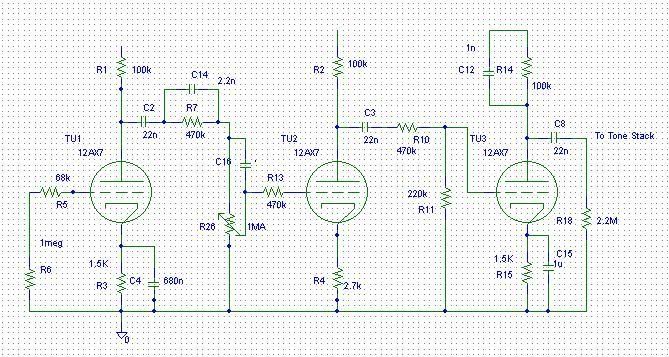Hi Larry,
Thank you for the loop schematic....much appreciated. I'm a student of Electronics Engineering, but, I'm very disappointed that no
college out there teached "tube theory" and design!! Maybe I'm fourty or so years too late...

. Anyway, I have a few questions,
if I may ask of you?
1) In past replies you spoke about the loops decibel characterists
"Now you could patch in a guitar cord from Send to
Return (instead of an effects device) and with the Send Level & Return Level dimed you'd get an additional boost of about +12dB.
To practice with this, set the Send
Level dimed and use the Return Level as a 'Post Gain Control"
and
"The dry path
of the loop has an attenuation of -33.0dB with the Return Level on zero or dimed and an attenuation of -32.5dB with the Return Level
on about 6...7, when nothing is plugged in.
The recovery stage has an amplification of +35.4dB, that means, that the signal with the loop will be slightly amplified by about +3dB - theoretical.
That's based on average tube datas, but when you have a pretty strong tube for the loop, then it might be a tad more, kinda +5dB...+6dB.
In this case you can fine tweak the attenuation by swapping the 68K with a 56K, a 47K or even a 39K for more attenuation, to
get to exactly that point, where it would be w/o the loop section"
I know you may not have time for a "tutorial" on circuit design
and analysis, but, any information is much appreciated.
My question is how are these measurements of this circuit calculated?
2) Can you help me with understanding the wiring for the input/output jacks? (I seem to be having a problem understanding
which are the ground, switch..etc lugs).
3) I believe, in one of your replies, you mentioned that this loop (when not used) does not color the amp except maybe +1 or +2 dB's. Is it a good idea to use a trim pot somewhere in the circuit to "tune" the circuit further to not have any dB boost when nothing is pluged in (0 dB's)? if so, where would you place that pot? (Note: on my work bench I do have a audio generator, DMM, O-Scope...etc. I'm thinking I would need to have some sort of an audio signal in the amp to see the input and output of this loop)
4) Any books I can purchase that you recoment that does a good job with tube theory and design?
5) I LOVE YOU LARRY !!!!!!! Will you adopt me ?

THANK YOU,
Ed

